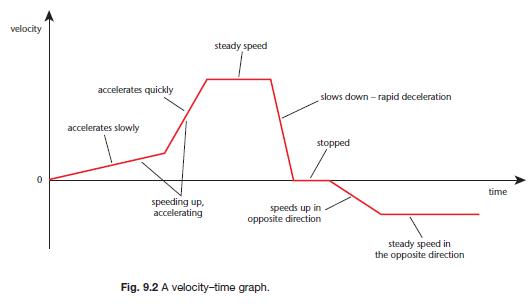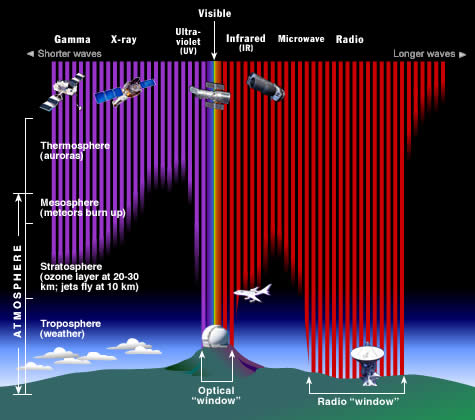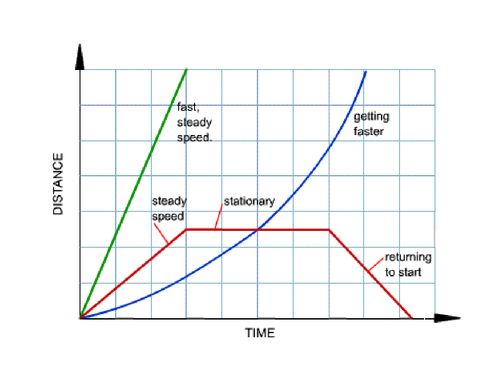PHYSICS
- Created by: pp1212
- Created on: 09-02-17 12:20
Distance Time Graphs
Gradient = speed
Speed m/s = distance m / time s
Velocity + Acceleration
Velocity is speed in a given direction
Acceleration is the change in velocity per second, squared. (m/s^2)
Deceleration is the change in velocity per second when an object slows down (neg. acceleration)
Braking reduces velocity of a vehicle.
VELOCITY TIME GRAPHS
-- horizontal line > acceleration is 0, stationary
Gradient of the line represents acceleration
Area under the line is the distance travelled
Velocity Time Graph

Forces
A force can change shape, state of rest or motion of an object. (unit newtons (N))
A FORCE ALWAYS CREATES AN EQUAL AND OPPOSITE FORCE REACTION
Quicksand causes you to sink because your force of gravity is greater than the upwards force of sand. Don't struggle, flatten yourself and crawl to safety.

Friction and Driving Force
Driving force (aka motive force) makes a vehicle move. The driving force is due to friction between the ground and the tyres of the vehicle. Friction acts where the tyre and ground are in contact.
When the car moves forward... (equal and opposite forces)
- the force of friction of the ground on the tyre is in the forward direction
- the force of friction of the tyre on the ground is in the reverse direction
Resultant Force
Resultant Force? = all the forces which act on an object
when resultant force is 0 object is stationary or at constant velocity (balanced forces)
if not 0 the velocity of an object changes
0< Resultant Force
the object's movement depends on the size and direction of the resultant force
When a plane takes off, the thrust force must be greater than the air resistance on it. The greater the resultant force, the faster the take off.
When a car driver applies breaks, the braking force is greater than the motive force. The resultant force will be the difference between the two forces as they act in opposite directions
5N <-- (-) -----> 30 N
resultant force = 30N - 5N = 25N
ON THE ROAD
Any car moving with constant velocity has a resultant force of zero. The driving force is balanced by resistive forces (such as friction and air resistance).
Braking force to stop a vehicle depends on... it's speed and mass vehicles with greater speed...need greater deceleration to stop the vehicle. therefore braking force for high speed must be greater than at a low speed.
STOPPING DISTANCE /!\ shortest distance a vehicle can safely stop =
The thinking distance (distance travelled in the time it takes for driver to react) which equals = vehicle's speed x driver's reaction time
+
The braking distance (the distance travelled in the time the breaking force acts) which equals = speed during braking x braking time
Braking distance is directly proportional to the square of car's speed
Stopping Distance Factors
- Tiredness, alcohol, drugs.
- Using mobile phone
- ^ increase thinking distance so increase stopping distance
- Speed - the faster a vehicle is travelling
- The further it can travel before it stops
- Increased speed= increased thinking + braking distance
- Bad road conditions- wet/icy
- Need to brake with less force to avoid skidding
- Stopping distance is greater in poor road conditions
- Poorly maintained vehicles, worn tyres/brakes, less effective
Falling
Weight is due to the gravitational force of attraction between yourself and the Earth.
Weight ~ force of gravity on an object (newtons)
Mass ~ quantity of matter in an object (kilograms)
---------------------------------------------------------------------------------------
Falling in fluid... the fluid drags on the object. Drag force increases with speed.
Resultant force is (weight - drag force)
Acceleration decreases as object falls. Because the drag force increases
Terminal Velocity is when (drag force = weight)
At terminal velocity, the resultant force is 0
Falling in air... Drag force is called air resistance
Stretching and squashing
Stretching and squashing
Elastic potential energy is stored when an object is stretched. Work is done on the object by the stretching forceWhen stretching force is removed, elastic energy is released > kinetic energy or heat energy
Issues- speed, cost, skidding
Costs: less speed = less fuel consumption.
Lorry drivers can attach wind deflectors that reduce air resistance. Saves money, as less force/power needed.
Danger!: 20mph stopping distance ~ 12m, 40mph ~ 36m, 60mph ~ 72m. force on a person increases with speed
Speed Cameras: where speed cameras were introduced... speed fell by 17%, deaths fell by 55%
Anti-skid Surfaces: rougher surface increases friction, reduces skidding when brakes applied and lighter surface so clearly marked out
Skidding: happens when brakes applied too harshly. with a rougher road surface, friction is increased so skidding is decreased
Energy + Work
WORK
when an object is moved by a force. causes a transfer of energy. energy transferred = work done
WORK on FRICTION
overcoming friction is transferred as heat energy
examples
rubbing hands creates warmth. your muscles do work to overcome friction between your hands. this work is transferred into energy that warms your hands.
Brake pads applied too long > hot. friction between pads and wheel opposes kinetic energy of car and energy transfers and heats. some energy may transfer into surroundings by sound waves (squealing brakes)
Potential Energy
Gravitational Potential = energy stored because of position in Earth's gravitational field.
Object ↑ increases gp energy.
Object ↓ decreases gp energy
Elastic Potential = stored energy in elastic material when work is done on it
Momentum
momentum has size and direction. momentum = mass x velocity
Law of Conservation of Momentum
(in a closed system) total momentum before = total momentum after
EXPLOSIONS
When objects push each other apart, they move apart...
(unequal mass) : with different speeds
with equal and opposite momentum
Electricity
Insulating materials become charged (static) when they rub together (friction).
Charging with Friction
rubbing a polythene rod with a dry cloth transfers electrons to the rod's surface from the cloth. rod becomes negatively charged
rubbing a perspex rod with a dry cloth transfers electrons from the surface of the rod to the cloth. rod becomes positively charged.
ElEcTrIc CiRcUiTs
Resistance
Ammeters - measures current in amps. connected in series to what it is intended to measure --
Voltmeters - measures potential difference in volts. connected in parrallel //
Electrons passing through a torch bulb push their way through vibrating ions in the metal filament. Ions resist the passage of electrons
Resistance = volts ÷ amps
measured in ohms. Ohm's Law states the current through a resistor is directly proportional to the potential difference across the resistor.
Current-Potential Difference Graphs
filament bulb: resistance increases with increased temp. non-ohmic conductor
diode: non-ohmic conductor. resistance in the reverse direction is much higher than forward
Thermistor + LDR
< Thermistor Temp increase = resistance decrease
 < LDR Light intensity increase = resistance decrease
< LDR Light intensity increase = resistance decrease
Series + Parallel Circuits
The same current passes through components in series with eachother. The current is the same in each.
Adding potential differences in each give the total resistance.
Parallel- the total current = currents in each components added
potential difference is the same across each component

Series + Parallel Circuits
The same current passes through components in series with eachother. The current is the same in each.
Adding potential differences in each give the total resistance.
Parallel- the total current = currents in each components added
potential difference is the same across each component

Electromagnetic Spectrum
Electromagnetic Spectrum...
EM radiation is like a stream of mass-less particles (photons) travelling in wave patterns. Types of EM radiation are differentiated by the amount of energy in the photons. Lowest-Highest energy below.
Types of electromagnetic radiation.
Radio: like radios for music. Stars and gases in space also emit
Microwave: food cooking. also by astronomers for galaxy measuring
Infrared: Night vision goggles, detects heat. infrared maps dust between stars
Visible: Our eyes detect visible light. Fireflies, light bulbs, and stars emit
Ultraviolet: Emitted by sun, UV lights
X-Ray: Medical, airport security. Emitted by hot gases in universe
Gamma Ray: gamma-ray imaging to see in body. PET Scans. biggest generator = universe
Measuring Electromagnetic Waves
Can be measured by their energy, wavelength or frequency.
Frequency: measured in cycles per sec. Hertz Wavelength: metres/km/ Energy: volts
radio: 1cm-1km wavelength or 30 gigaHertz-300 kiloHertz frequency (kHZ)
infrared: microns (millionths of a meter) for wavelengths, range of 1 to 100 microns
visible: 10-7 cm, nanometers. 400-700 nanometers. So we only see a tiny part of entire spectrum
wavelengths of ultraviolet, X-ray, and gamma-ray are too small so usually are measured by energy of their photons. (electric volts).
Ultraviolet: ≤100 eV
X Ray: 100eV-100keV
Gamma Rays: >100keV
EMS and EARTH

Small Mass Star Lifecycle
(1) Nebula < high density mass of gas/dust which contracts under it's own gravity. (2) Condensing matter heats up and the NEBULA forms a PROTOSTAR.
(3) at 15 million° centigrade, nuclear reactions where hydrogen > helium begin. Star starts releasing energy and is now a MAIN SEQUENCE STAR
(4) (Lighter) stars in main sequence for about 10 billion years, until all hydrogen fuses to helium
(5) helium core contracts, reactions in a shell around the core. Core is hot enough for helium to form carbon> outer layers expand + cool, release less energy. Expanding star is a RED GIANT
6) Helium core exhausts. Outer layers emitted/drift away. Gas around the core is a planetary Nebula (7) the remaining core = WHITE DWARF, cools/dims/stops emitting > dead BLACK DWARF
Massive Star Life Cycle
evolve the same way as small mass stars until MAIN SEQUENCE.
emits all hydrogen and becomes mostly helium in millions of years (quicker).
when running out of hydrogen fuel the core collapses. raises core temp a lot, rate of helium fusion goes into overdrive
becomes RED SUPER GIANT helium core pushes layers of cooling, expanding gas. core gets hotter + hotter. Nuclear fuel burnt very quickly because of "giant" size. shorter lives
RSG forms heavier and heavier elements in the core. Core now mostly iron, takes more energy than the star has. Star cannot sustain and begins to collapse. Explodes.
Supernova. Explosive death. highest brightness. forms either a Neutron Star or Black Hole
Neutron star- forces protons and electrons to combine. very dense
Black hole- gravitational pull is so high nothing can escape, not even light. cannot be measured. **** and will distort matter around them.
Life Cycle Star Diagram
The Gas Laws
Boyle's Law...
Decreasing the volume of space in which a gas is enclosed causes particles to collide more with the surface of the container and eachother. Pressure and volume are inversely proportional
= decreasing volume > increases pressure =
Pressure and Temperature...
A gas contained, volume of container stable (⇵) Adding heat increases the particle's energy so they will move faster and collide with walls.
The Gas Laws
Boyle's Law...
Decreasing the volume of space in which a gas is enclosed causes particles to collide more with the surface of the container and eachother. Pressure and volume are inversely proportional
= decreasing volume > increases pressure =
Pressure and Temperature...
A gas contained, volume of container stable (⇵) Adding heat increases the particle's energy so they will move faster and collide with walls.




Comments
No comments have yet been made